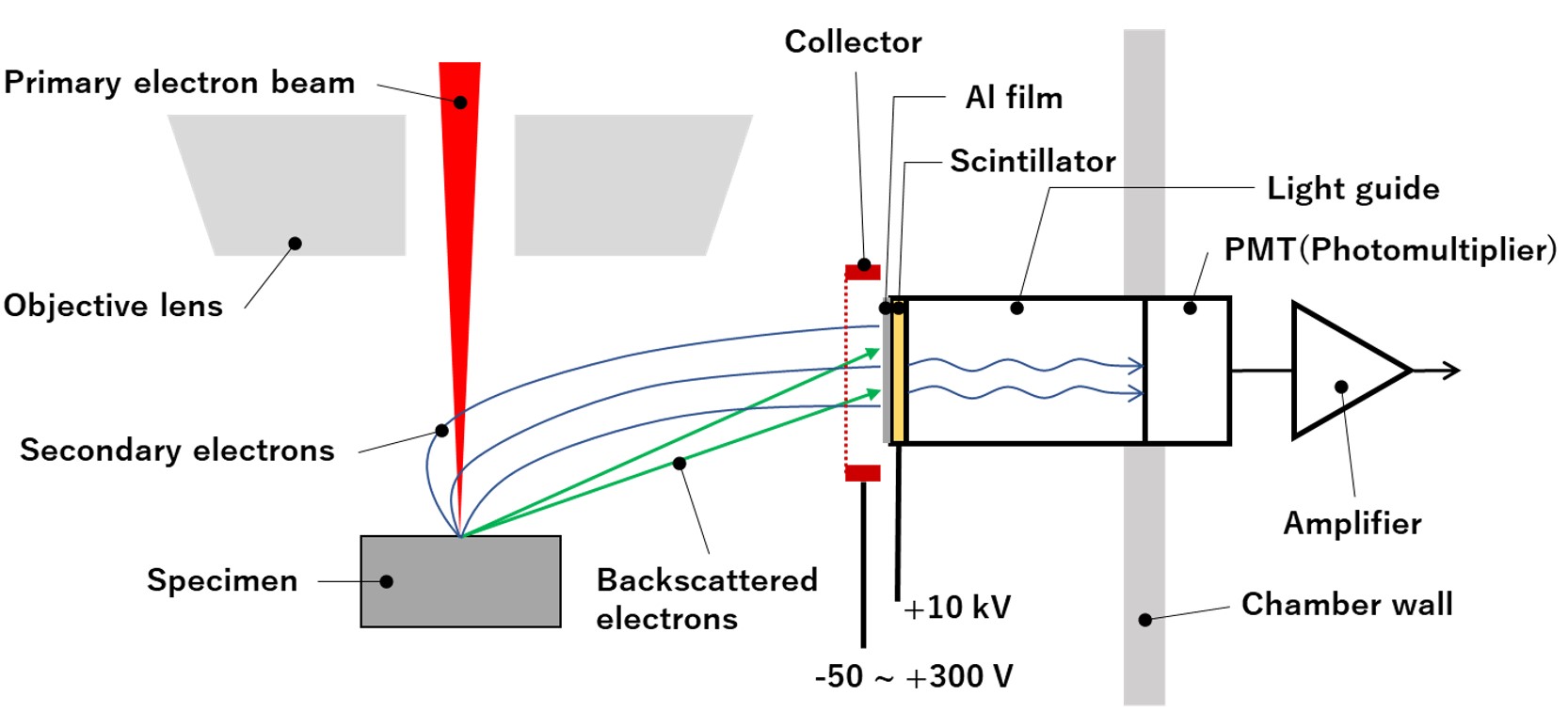二次電子検出器、ET検出器
二次電子検出器、ET検出器
SED, secondary electron detector, SE detector, ET detector, SED
[目次:装置]
最も広く使われている二次電子検出器は、シンチレーター(蛍光物質)と光電子増倍管を組み合わせたET検出器である。この検出器の名前は、開発者のEverhartとThornley の名前に由来する。
汎用型のSEMでは、試料は対物レンズの外(下側)に置かれ、ET検出器は対物レンズと試料の間の空間すなわち試料室の側面に取り付けられている。ET検出器の構造および対物レンズと試料の位置関係を下の図に示す。
イットリウムシリケートの粉末材料からなるシンチレーターの表面にはアルミニウム(Al)の蒸着膜があり、その前にはコレクターと呼ばれる電極が配置されている。コレクターには数100 Vまでの電圧をかけることができ、その電場によって、試料から放出された二次電子は検出器に集められる。検出器に導かれた二次電子は、シンチレーターのAl蒸着膜に印加した+10 kVの高電圧によってさらに加速され、シンチレーターに衝突し、発光する。その光は、ライトガイドを通して光電子増倍管(PMT)に導かれ、再び電子に変換され増倍される。増倍された電子は陽極に到達し、接続された電気回路にて電圧信号に変換され増幅される。
高分解能SEMでは、試料を対物レンズの中に(あるいは対物レンズに近づけて)置くので、二次電子は対物レンズの中で発生する(あるいは対物レンズの中に進入する)。この二次電子を捕獲するために、検出器は鏡筒の内部に置かれる。
二次電子検出器として広く用いられるET検出器は、YAG検出器と同様にシンチレーターを用いた検出器なので、応答速度に優れている。そのため、速い走査や試料ステージを移動しても像がぼけることなく、時間の遅れなしに試料の像を観察することができる。なお、反射電子の検出には、シリコン半導体検出器を用いるのが主流であるが、高い応答速度を求める場合にYAG検出器を用いる。

図.二次電子検出器(ET検出器)
試料から放出された二次電子はコレクターによって二次電子検出器に導かれる。導かれた電子はシンチレーターによって光に変換され、光電子倍増管によってふたたび電子に変換され増倍されて電流信号となる。電流信号は接続された電気回路にて電圧信号に変換され増幅される。シンチレーターの表面は放電による劣化を防ぐためにアルミニウムでコーティングされている。二次電子検出器にはわずかながら反射電子も飛来する。シンチレーターには結晶性のYAGよりも安価な粉末状イットリウムシリケート材料を用いる。
The most widely used secondary electron (SE) detector is the ET (Everhart-Thornley) detector, which is composed of a scintillator and a photomultiplier tube (PMT). The name of the ET detector is originated from the inventors of this detector, Everhart and Thornley.
In a general-purpose SEM, the specimen is placed outside (underside) of the objective lens, and the ET detector is attached in the space between the objective lens and the specimen (on the side part of the specimen chamber). Figure below shows the construction of the ET detector and the positional relation between the objective lens and specimen.
The surface of the scintillator, which is made of powders of yttrium silicate, is aluminum (Al) coated. An electrode (called “collector”) is placed in front of the scintillator.
A voltage up to several 100 V can be applied to the collector. The electric field generated by the applied voltage collects the secondary electrons emitted from a specimen. Those electrons guided to the scintillator are further accelerated by a high voltage of +10 kV applied to the Al-coated film of the scintillator and hit the scintillator, causing light emission. The emitted light is guided to a PMT through a light guide tube, and converted back to electrons and are multiplied. The multiplied electrons arrive at the anode and are converted to a voltage signal and amplified by the electric circuit connected to the PMT.
In a high-resolution SEM, the specimen is placed in (or close to) the objective lens. Thus, secondary electrons are generated in (or enter) the objective lens. To collect these secondary electrons, the ET detector is placed inside the microscope column.
The ET detector, which is widely used as the SE detector, has a high response speed because it uses a scintillator like the yttrium aluminum garnet (YAG) detector. Therefore, the image of the specimen can be observed with no blurring and without time lag even at fast scanning or moving the specimen stage.
It is noted that for detecting backscattered electrons, a silicon (Si) semiconductor detector is mainly used but a YAG detector is used when a high response speed is required.

Fig. Secondary electron detector (ET detector)
Secondary electrons emitted from a specimen are guided to the SE detector (ET detector) by the collector. The guided secondary electrons are converted to light by the scintillator and converted back to electrons by the PMT, where they are amplified and become an electric current. The electric current is converted to a voltage signal and amplified by the connected electrical circuit. The surface of the scintillator is aluminum-coated for preventing the deterioration of the surface caused by discharge. It is noted that a few amounts of backscattered electrons are also detected with the ET detector.
The scintillator is made of powdered yttrium silicate, which is less expensive than crystalline YAG.
関連用語から探す
説明に「二次電子検出器、ET検出器」が含まれている用語






